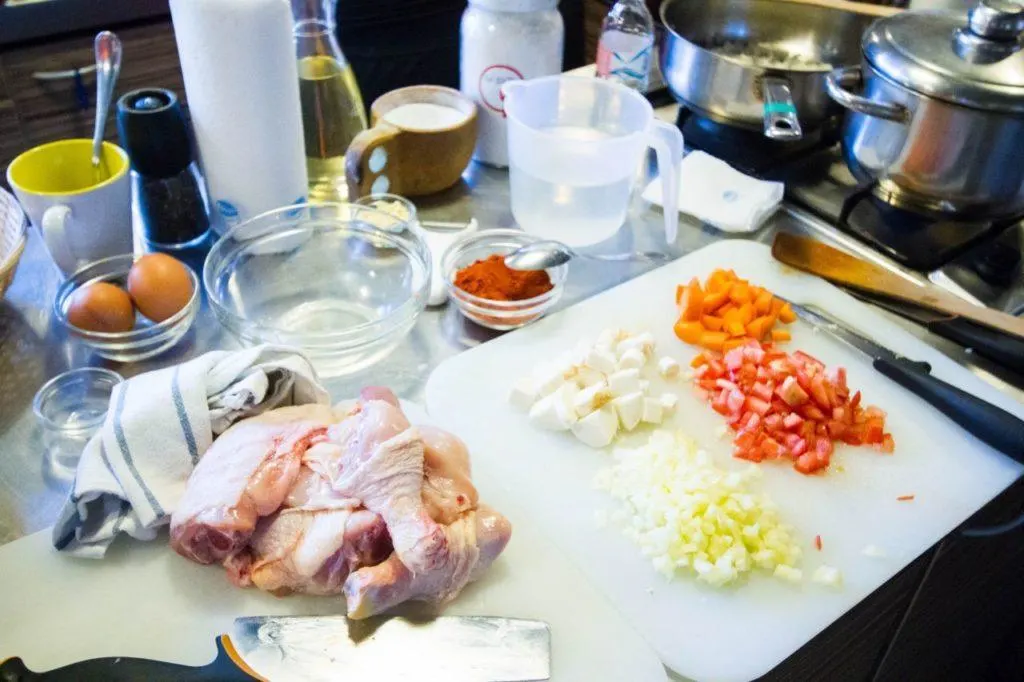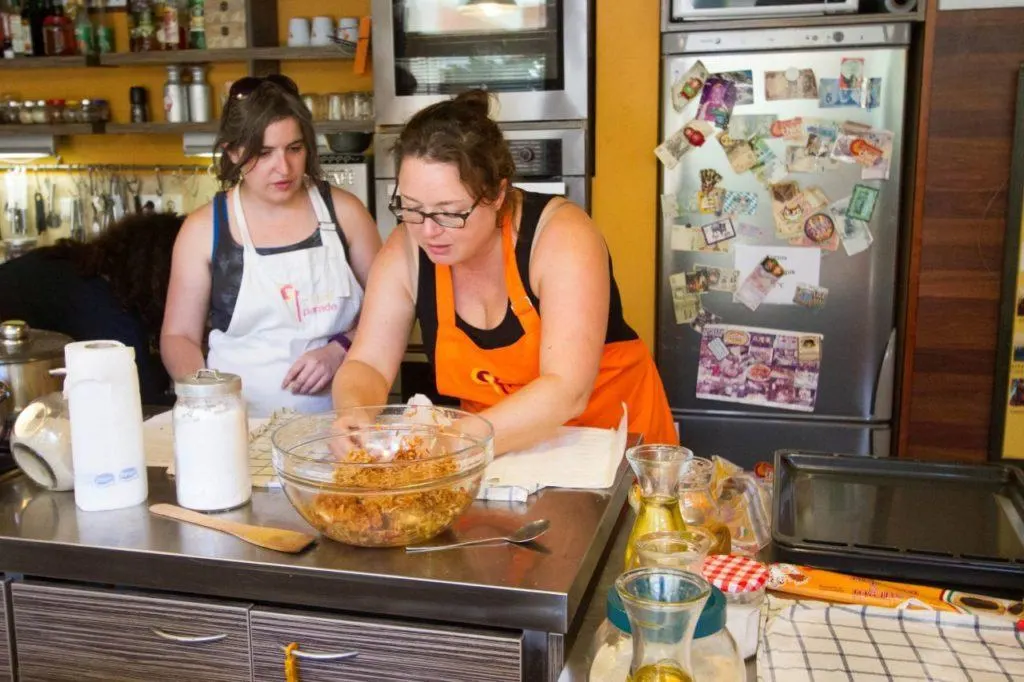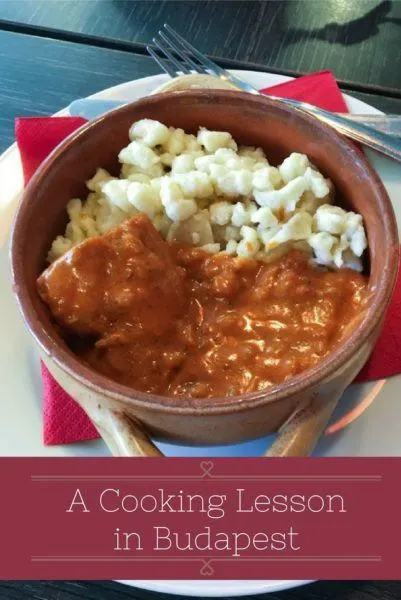We had a fun and fantastic morning at Chef Parade with Anna. If you are there, even for just one day, I highly recommend you take a cooking lesson in Budapest.
Anna greeted us at the door of the Chef Parade school where we were signed up to take our first Hungarian cooking lesson in Budapest. An inviting space, the school is split into two halves, one side kitchen and one side table. The table was strewn with cookbooks, so while we waited we perused all the fabulous recipes. Now, you know one of the dishes I wanted to learn how to make was dumplings. Luckily, the other dish was Chicken Paprikash, a Hungarian staple, and it was paired with dumplings so I thought I was covered.

Anna and her colleague had set up all of the kitchen stations (2 people to a station) and as soon as everyone got there, quick introductions were made, hands were washed, and we started chopping, dicing, and cutting all kinds of vegetables. At this point, I learned my first lesson of many.

Anna picked up the celery root and told us that when celery is called for in Hungarian recipes, it means to chunk up the root, not the stems like we do in the US. She then proceeded to cut off pieces for everyone to try. Yes, it tasted like celery. Personally, I’m not a fan of those little celery strings, so I might try to use the root in other recipes as well.
I’m not a patient cook, so while Jim did the majority of the chopping, saucing, whatever-ing, I peppered Anna with questions. I had been perplexed over one food question. Everything you read tells you that the national dish of Hungary is Chicken Paprikash, but looking for it on the menus in Budapest I found it near impossible to find.

We followed one website to a small little cafe and it did serve it, but it wasn’t very appetizing. It certainly didn’t live up to the dish in my mind. I tried and tried to find it other places to no avail, so I had to ask. If Chicken Paprikash is the national dish, how come I can’t find it on any of the menus?
Anna’s eyebrows shot up. She said that I was right, it was hard to find. She explained that during the Soviet rule, Hungarians were only allowed to serve 10 dishes, one being Chicken Paprikash and the world started to think that was their special dish. It really wasn’t. It was just one of the “allowed” dishes. Of course the follow up question was, what is a special dish?

I was startled by the answer, “sausage, fish, and potatoes.” Apparently during family and group get-togethers big pots of fish,
potatoes, and fried sausages is what everyone looks forward to eating. This bit right here, sussing out a myth and finding out what real people do, makes paying for a cooking lesson so worth it!

Making the chicken paprikash, even though it was still morning time and we’d just finished breakfast, made our mouths water. The sauce was so aromatic and enticing. I kept dipping my spoon into it. Well, you are supposed to taste what you serve, right?! The girls’ sauce was a beautiful reddish-orange color which Anna said was perfect. Jim’s and my sauce had turned a bit brownish, and she just said that’s the way her dad liked it. I read “burnt” in the subtitles, but didn’t want to burst Jim’s pride. Color right or not, it did taste quite yummy.

As the chicken stewed, we moved on to making our dumplings. They were just like German spaetzle, which I had made them before, but it was still fun and Anna gave us a few hints about the best way to do this or that. These are things you only learn by doing!

Here again, I asked her how she learned to cook and she chuckled and replied, “I don’t understand that question. I didn’t learn to cook. Everyone knows how to cook. You have to cook to survive. When I was a little girl, my mother would have to work. She set out the ingredients for dinner, and I made it. That’s all. I cooked or we all didn’t eat.”

Anna found it funny that we think we have to purposely learn to cook. Maybe that’s one difference from growing up in America versus the countries controlled by the Soviets. My mom mostly stayed home when I was little, and in the US we have every kind of “quick” method possible. Do we really need to learn to cook?

Next on the agenda was the strudel. First we made a number of fillings, then we rolled the strudel. We had poppyseed, sour cherry, apple, and walnut. They were all amazing!

At last, we sat down with the food we had made, and we ate, and ate, and ate. It was so filling, so delicious, that we didn’t have to eat another meal all day. (Note: I said a meal…I didn’t say anything about coffee and cake, now did I?)
We had a fun and fantastic morning at the Chef Parade with Anna. If you are visiting, even for just one day, I highly recommend you take a cooking lesson in Budapest. You will learn more than a few recipes; you will learn about Hungarian life.
Chef Parade
Budapest, Páva u. 13, 1094 Hungary
+36 1 210 6042
Have you taken cooking lessons anywhere else?
Author Bio: Corinne Vail is a travel photographer, food lover, and a perpetual traveler who has been travel writing for over 14 years. For many years she lived overseas in Germany, Japan, Turkey, South Korea, and the Netherlands teaching the children of the US. military. She’s visited over 90 countries, and she’s not stopping anytime soon.
Pin our Hungarian Cooking Lesson for later.


Anda
Saturday 29th of October 2016
My husband is Hungarian so I learned to cook a great deal of Hungarian dishes, but I don't like staying in the kitchen. I wish I had a cook, or at least a helper to get all the ingredients ready for me. My favorite one is the veal paprikas.
Corinne Vail
Saturday 29th of October 2016
Anda, I've never tried veal paprikas, but I'm sure it's amazing. I love being in the kitchen, but I certainly don't have to be the one cooking.